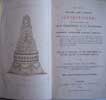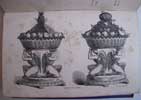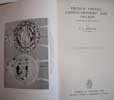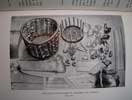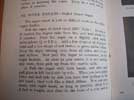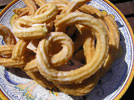The Modern Cook
A PRACTICAL GUIDE TO THE CULINARY ART IN ALL ITS BRANCHES; COMPRISING IN ADDITION TO ENGLISH COOKERY, THE MOST APPROVED AND RECHERCHE SYSTEMS OF FRENCH, ITALIAN, AND GERMAN COOKERY. ADAPTED FOR THE LARGEST ESTABLISHMENTS AND FOR PRIVATE FAMILIES. CHARLES ELME FRANCATELLI, PUPIL OF THE CELEBRATED CAREME, AND LATE MAITRE-D'HOTEL AND CHIEF COOK TO HER MAJESTY THE QUEEN. WITH SIXTY ILLUSTRATIONS. ELEVENTH EDITION CAREFULLY REVISED, AND CONSIDERABLY ENLARGED. LONDON: RICHARD BENTLEY SON, NEW BURLINGTON STREET. Publishers in Ordinary to Her Majesty.
Undated but printed 1853. Marbled paste-down and endpaper. [2] Frontisepiece of a young Francatelli, slightly foxed and laid down on a strip to re-inforce the edges and with the gutter re-inforced. Title page age browned. [1] 1p Dedication. [1] 2p Preface. (1)-xii Contents. (1)xiv-xv Glossary. [1] (1)2-474. (1)476-538 Bills of Fare. (1)540-552 Index. [1] Marbled back paste-down and endpaper. Dark blue half calf with dark blue cloth boards. The spine slightly sun bleached with raised bands, gilt lines and lettering.
- One of the culinary legends of his time, Charles Elme Francatelli(1805-1877) was an Englishman of Italian ancestry who journeyed to France for the opportunity to work under the legendary Chef Marie Antoine Careme who many call "the architect of French cuisine." Francatelli was revered for his blending of the best of Italian and French cuisine, it wasn't long before he was appointed "Chef de Cuisine" to the Earl of Chesterfield and later to both the Earl of Dudley and Lord Kinnaird. When Francatelli tired of his royal duties he detoured into public life where he seized the reins of the Crockford's Club which was the place to be seen in the mid 1800's. He later moved on to take a turn at the St. James's Club where he attracted the attention of her Royal Highness Queen Victoria who wooed him into her employ. But the public life was in Francatelli's blood and even the Queen could not hold him for long. He moved on to become the 'chef en charge' at the Coventry House Club, then went off to put in seven years as the chef de cuisine to the Reform Club, and had stints at the St. James's Hotel, Berkeley Street, Piccadilly, and finished his career at the Freemasons' Tavern where he remained until just before his death. The Times attributed to him, the following side-note; "A chef to nobility and a cook for the common man" Although Francatelli had the experience, charm and flourish necessary to please the highest of Royalty, his greatest love was the simple act of cooking. In 1845, he published his first book "The Modern Cook." in England and in America in the following year. The book sold well on both sides of the Atlantic and was so popular that it went through an amazing twelve editions. In it, he advocated two courses for meals -- a savoury followed by dessert, which is how most everyday eating is done now. Besides "The Modern Cook" Francatelli wrote three other cookery classics; * 1852. A Plain Cookery-Book for the Working Classes (contained over 240 recipes). * 1861. Cook's Guide and Housekeeper's Butler's Assistant. London: Richard Bentley and Son. * 1862. The Royal English and Foreign Confectioner. London: Chapman and Hall.




click on image to enlarge

Antiquarian category
ref number:
11029 










